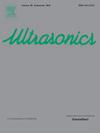变截面结构兰姆波检测中换能器阵列优化方法
IF 3.8
2区 物理与天体物理
Q1 ACOUSTICS
引用次数: 0
摘要
复杂截面结构在航空航天制造中有着广泛的应用,开发基于Lamb波的结构健康监测方法引起了人们的关注。然而,几何结构的复杂性使得色散计算和换能器的布置变得困难。结构截面厚度的变化引起兰姆波群速度的不均匀。因此,波的传播导致能量分布不均匀,这给结构健康监测的应用带来了挑战。虽然传统的相控阵可以用来解决能量聚焦的问题,但其实施往往使原位监测过程复杂化,从而增加了相关的成本。本文提出了一种用于兰姆波检测的柔性换能器阵列布置的高效优化方法。以钛合金发动机风扇叶片为例,对该方法进行了验证。为了避免在阵列布局中进行繁琐的大规模随机采样,获得更好的兰姆波检测性能,引入矩交法生成具有代表性的稀疏样本进行仿真。采用连续截面映射改进的半解析有限元法(SAFE)分析兰姆波色散并选择所需模态。采用动态模拟的方法研究了波的运动,特别是优化参数对波聚焦的影响。利用仿真结果建立了聚焦能量的多项式模型,进一步得到了换能器的优化布置方案。通过仿真和实验验证了该方法的有效性。本文章由计算机程序翻译,如有差异,请以英文原文为准。
A novel optimization method for transducer array in Lamb wave detection of variable cross-section structures
Structures with complex cross-sections are widely applied in aerospace manufacturing and developing a Lamb wave-based structural health monitoring method for the structure has attracted interest. However, the complex nature of geometry makes dispersion calculation and transducers arrangement difficult. The variation in the thickness of the structural cross-section gives rise to disparities in the group velocity of Lamb waves. Consequently, the wave propagation leads to an uneven distribution of energy, which poses challenges for the applications of structural health monitoring (SHM). Although traditional phased arrays can be employed to address the issue of energy focusing, the implementation often complicates the in-situ monitoring process and consequently increases the associated costs. This article presents an efficient optimization method for flexible transducer array placement of Lamb wave detection. A real titanium alloy engine fan blade is employed to demonstrate and validate the proposed method. For better Lamb wave detection performance without cumbersome large-scale random sampling in array layout, the moment quadrature method is introduced to generate representative sparse samples for simulation. The process of the semi-analytical finite element (SAFE) method, which is improved by continuous cross-sections mapping, is conducted to analyze Lamb wave dispersion and select the desired mode. The dynamic simulation is employed to study the wave motion, especially the effects of optimized parameters on wave focusing. The simulation results are applied to build a polynomial model of focused energy and further obtain the optimized schemes for transducers arrangement. Validations in both simulations and experiments are performed to verify the performance of the proposed method.
求助全文
通过发布文献求助,成功后即可免费获取论文全文。
去求助
来源期刊

Ultrasonics
医学-核医学
CiteScore
7.60
自引率
19.00%
发文量
186
审稿时长
3.9 months
期刊介绍:
Ultrasonics is the only internationally established journal which covers the entire field of ultrasound research and technology and all its many applications. Ultrasonics contains a variety of sections to keep readers fully informed and up-to-date on the whole spectrum of research and development throughout the world. Ultrasonics publishes papers of exceptional quality and of relevance to both academia and industry. Manuscripts in which ultrasonics is a central issue and not simply an incidental tool or minor issue, are welcomed.
As well as top quality original research papers and review articles by world renowned experts, Ultrasonics also regularly features short communications, a calendar of forthcoming events and special issues dedicated to topical subjects.
 求助内容:
求助内容: 应助结果提醒方式:
应助结果提醒方式:


